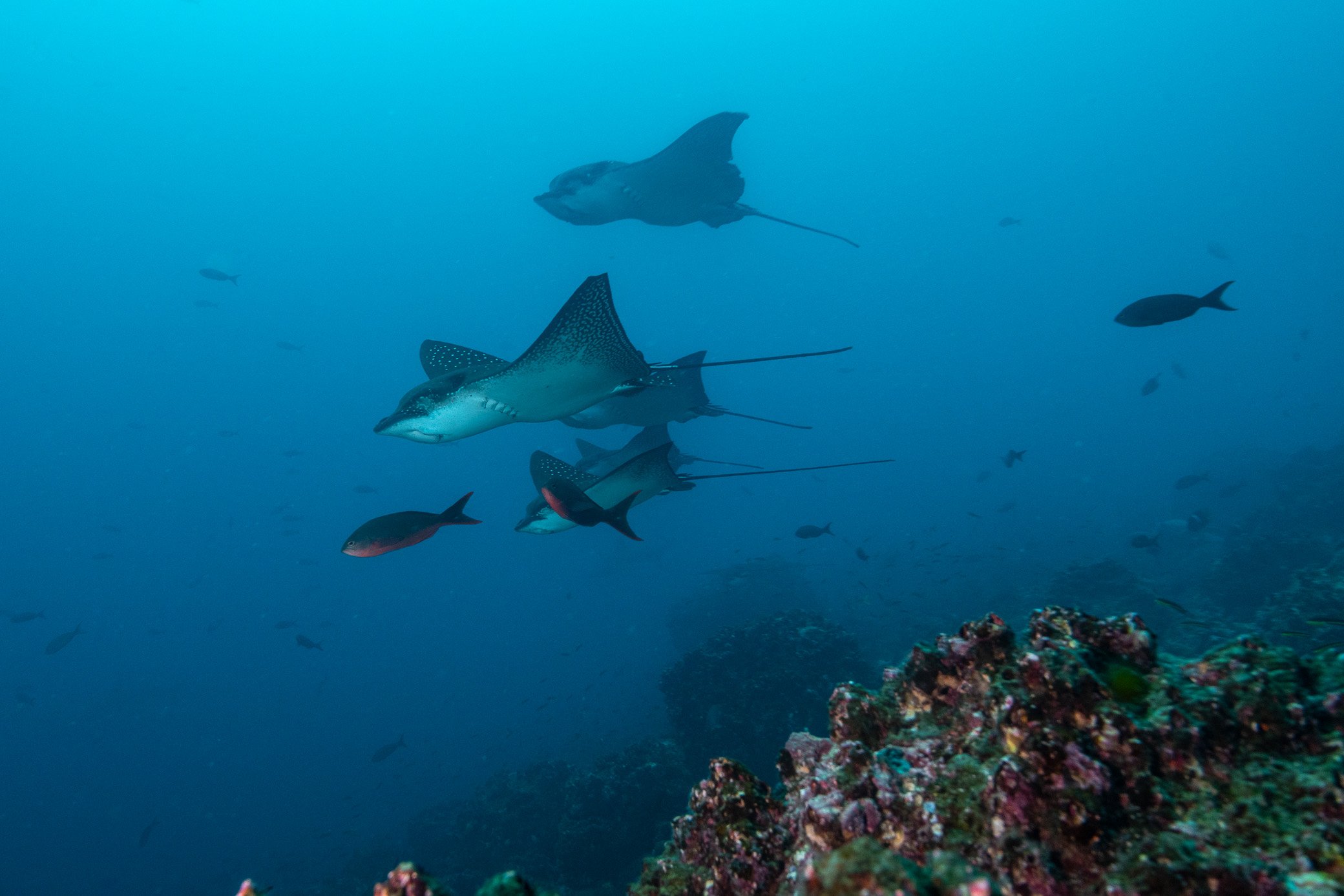Galápagos Diving from a Photography Perspective | Wolf Island | Part 5
This series of posts is about an 11-day liveaboard trip throughout the Galápagos Islands aboard the Deep Blue with the Master Liveaboard Fleet. Having shot several thousand images, I thought I would share a few more here than on my other social channels, but be sure to check out my Instagram, TikTok, Youtube, and Twitter for more. This part is about the first days, including diving at Wolf Island. Have a look at the other posts in this series.
Back from Darwin to Wolf Island
Wolf Island is one of the thirteen main islands of the Galapagos Archipelago. The uninhabited island is home to a large number of seabirds.
Seabirds forage on small fish from the water surface near Wolf Island.
The uninhabited Wolf Island, located in the north of the Galapagos Archipelago, is home to a large number of birds.
It is only about two to three hours of steaming from Darwin to Wolf, but I wondered why we had split the Wolf Diving. Geoff's answer was that all decisions regarding diving in the park are made by the Galapagos National Park, and for some reason, they had instructed the Deep Blue to do as we did. It didn't seem to make much sense as when we arrived at Darwin, we had three other diving boats there, whereas the day after, only one. It didn't matter in the end, as we only ever encountered one other group while diving in the Galapagos (and that was in Darwin), and that was only for a few minutes. The good thing was that when I woke up back at Wolf Island on the morning of our fifth day, we were the only liveaboard here.
Great surprise: a pod of orcas welcomes us
We encountered a small pod of orcas (Orcinus orca), maybe five or six animals
Portrait of a surfacing orca (Orcinus orca).
The large dorsal fin of an orca (Orcinus orca).
Shortly after breakfast, the captain rooted the ship's horn and started shouting, "Orcas, orcas!". We rushed to the top of the Deep Blue and spotted the pod of orcas a few hundred meters away. "How amazing is this?"' I thought to myself. Orcas in the wild!! The captain lifted the anchor, and we started to steam towards the pod. For the next half hour or so, we crisscrossed the bay area where the pod was swimming and got a few super close sightings.
A few of the larger ones even decided to surf small waves beside the boat and came to check us out repeatedly. I had the camera all set up in the housing, which was ready to go and vacuum-pumped, but when it was clear what was happening, I ran down, got my camera pout again, exchanged the wide-angle for the incredible Nikon 150-500mm and starting shooting away. I was honestly mind-blown! I even went a step further in my mind: what if we saw them underwater later...?
Back in the water: spotted eagle rays, hammerhead sharks and turtles
The two dolphins that quickly appeared for a few seconds before moving on.
A group of spotted eagle rays(Aetobatus narinari) passing by in the waters surrounding Wolf Island, Galapagos Archipelago. Spotted Eagle Rays are considered ‘Endangered’ by the International Union for Conservation of Nature (IUCN).
Eagle rays, galapagos sharks and scalloped hammerhead sharks belong to the frequent sights while diving the waters around Wolf Island in the Galapagos Archipelago.
A curious Green Turtle (Chelonia mydas).
Scalloped hammerhead sharks and spotted eagle rays.
A school of Yellowfin Tuna (Thunnus albacares).
A school of scalloped hammerhead sharks (Sphyrna lewini)
A school of Yellowfin Tuna (Thunnus albacares).
A school of scalloped hammerhead sharks (Sphyrna lewini) encountered near Wolf Island, Galapagos Archipelago. Scalloped hammerhead sharks are classified as ‘Critically Endangered’ by the International Union for Conservation of Nature (IUCN).
Frigatebirds circling above the water surface of the Pacific OCean near Wolf Island in the Galapagos Archipelago.
A frigatebird circles the cliffs of Wolf Island in the Galapagos Archipelago, Ecuador.
A Rose Flower Urchin (Toxopneustes roseus).
A school of Cortez Sea Chubs (Kyphosus elegans) encountered in the shallow waters surrounding Wolf Island in the Galapagos Archipelago.
Portrait image of the Bravo Clinid (Gobioclinus dendriticus), a small blenny native to the Galapgos Islands and Malpelo. Photographed during a dive near Wolf Island in the northern part of the Galapagos Archipelago.
A playful Galápagos Sea Lion (Zalophus wollebaeki) in the shallows.
A playful Galápagos Sea Lion (Zalophus wollebaeki).
A school of Cortez Sea Chubs (Kyphosus elegans).
Several Common Bottlenose Dolphins (Tursiops truncates) visit the boat in the afternoon. Bottlenose dolphins are considered “Vulnerable” by the International Union for Conservation of Nature (IUCN).
Back in the water for our first two dives before lunch, I couldn't help but think about the orcas. Would they come to check us out underwater? I was crossing every finger I had.. Every time we were watching a group of sharks or rays, and they would disperse suddenly without any (to me) apparent reason, I was literally expecting a pod of orcas coming out of the blue. Unfortunately, it didn't happen. BUT, I did get to see two dolphins for a few seconds. It was not long, at least 20 m away, but I did manage to snap this quick image of the two, I'd guess, mom and baby.























